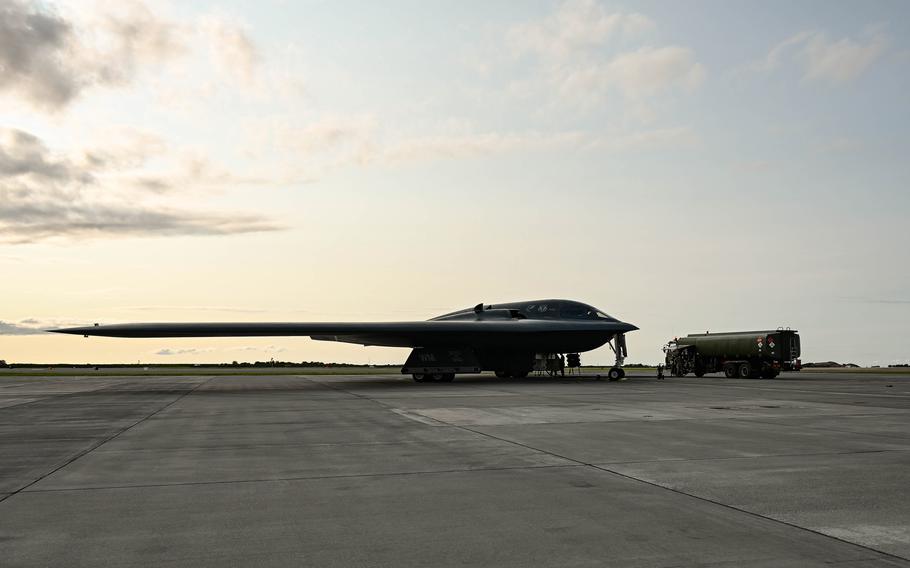A US B-2 Spirit bomber recently carried out a historic hot pit refueling at Orland Air Base, Norway, marking the first landing of the stealth bomber in the Scandinavian nation.
As per the US Air Force statement, the event occurred on August 29 and serves as a symbol of the joint commitment between the United States and Norway to deter potential threats and enhance the NATO Alliance.
Hot-pit refueling is an efficient technique employed to minimize aircraft downtime and enhance overall reliability. Instead of shutting down the aircraft’s engines after landing and parking, the aircrew keeps an engine operational while refueling takes place. This method ensures a continuous and streamlined refueling process.
The service said that the practice of hot pit refueling within NATO nations enables the B-2 to expand its fuel range while minimizing its downtime on the ground, ultimately enhancing the capacity to bolster combat airpower across the European theater for the United States and its allied partners.
According to Gen. James Hecker, who leads US Air Forces in Europe & Africa and NATO Allied Air Command, hot-pit refueling is evolving as a transformative tactic in bomber operations, offering increased adaptability.

This clever technique expands USAF’s operational reach, establishing temporary hubs at strategically selected and sometimes unexpected locations. These flexible capabilities form the cornerstone of modern airpower projection.
The B-2, one of three Spirit bombers stationed at Whiteman Air Base in Missouri, has been deployed to Iceland’s Keflavik Air Base. Simultaneously, a contingent of roughly 150 skilled airmen from the 509th Bomb Wing was dispatched on August 13 to lend invaluable support to this vital overseas mission.
This mission holds special significance as it marks the first return of the aircraft to the European theater following their last deployment to the continent in 2021.
These aircraft were temporarily grounded for five months starting in December due to safety concerns triggered by a fire incident involving one of the bombers.
In their current European assignment, the B-2 bombers are engaging in extensive training exercises alongside NATO and US Air Force units, although the precise duration of their stay remains unknown.
US Bomber Missions In Europe
In recent years, the strategic importance of operations in the High North has surged, exemplified by the deployment of B-2 stealth bombers to this region.
This heightened significance is linked to the evolving landscape of climate change, which potentially foresees the opening of an Arctic passage during the summer months in the not-so-distant future.
Simultaneously, uncertainties have arisen concerning the security of Northern Europe due to the profound impact of events in the Ukraine conflict and the incorporation of Finland and Sweden into NATO.
Considering this perspective, the US Air Force highlighted the paramount importance of US forces and equipment seamlessly operating alongside its Allies and Partners, recognizing that this synergy is essential for strengthening an expansive network of alliances and partnerships capable of effectively addressing both current and future challenges.
U.S. Air Force Lt. Col. Andrew Kousgaard, 393rd Expeditionary Bomb Squadron commander, said, “The long-range, penetrating strike the B-2 provides is a truly unique capability in the world, but long-range requires a lot of gas.”
“Honing our ability to interoperate with our allies and utilize partner-nation equipment and infrastructure to refuel can significantly reduce what we often call our ‘tanker bill;’ in some cases, it could be the difference between mission success and failure,” Kousgaard said.
The brief mission to Norway also aligns with the US Air Force’s ongoing commitment to exercise its agile combat employment concept, which aims to strategically reposition aircraft and airmen across various airfields to prevent them from becoming static targets in the event of a large-scale conflict.
In June, a pair of B-1B Lancer bombers from Texas made history by landing at Sweden’s Lulea Kallax Air Base during their deployment at RAF Fairford in England.
Since 2018, the United States has been conducting strategic bomber missions in Europe with the primary objective of acquainting their crews with the region, as well as nurturing relationships with NATO allies and partners.
Overall, the service believes that the greater their ability to seamlessly integrate forces and equipment for strategic maneuvering across Europe, the better prepared they become to effectively confront security challenges, both in the present and in the years ahead.
- Contact the author at ashishmichel(at)gmail.com
- Follow EurAsian Times on Google News